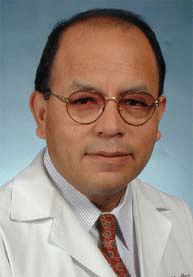Induction chemotherapy resulted in good disease control for patients with cancer at the base of the tongue, according to data from a small study at the University of Oklahoma. The value of induction chemotherapy in these patients remains controversial, however, and is the subject of four ongoing phase III clinical trials.
Explore This Issue
May 2008Physicians have traditionally treated patients with cancer at the base of the tongue (BOT) with surgery or, more recently, with concurrent chemoradiation. Several research groups hypothesize that treating these patients with chemotherapy before concurrent chemoradiation may reduce the mass of the tumor, decreasing the amount of chemoradiation necessary to cure the tumor and potentially improving overall survival.
Single-Institution Experience
To learn whether induction chemotherapy works in their own center, Jesus E. Medina, MD, Professor and Chairman of the Department of Otorhinolaryngology at the University of Oklahoma, and colleagues enrolled 18 patients with stage III or IV BOT cancer in a single-institution cohort study. Patients received up to three cycles of induction chemotherapy every 21 days, including 175 mg/m2 paclitaxel, 60 mg/m2 cisplatin, and 1000 mg/m2 ifosfamide. Following induction chemotherapy, patients received seven weeks of concurrent chemoradiation with paclitaxel and carboplatin. Patients who showed no response after two induction cycles were referred to surgery and adjuvant radiation. Patients who had a complete response after two cycles progressed immediately to concurrent chemoradiation, skipping the third induction cycle.
The preliminary results of the study, which the researchers presented at a 2008 Triological Society section meeting, indicate that 17 patients had at least a partial response to therapy. Eight patients had a complete response after two cycles, and four more showed a complete response after three cycles of induction chemotherapy. Five patients attained a complete response only after chemoradiation. One patient who did not respond to induction therapy refused surgery, went off-study, and subsequently died from the disease.
With a median follow-up of 29.6 months for the 17 patients who remained on-study, two patients have been lost to follow-up, fourteen are relapse-free, and one patient suffered a distant recurrence.
Three patients developed neuropathy during induction therapy, but the side effect resolved itself. Twelve patients required a temporary PEG tube, and three (17%) individuals required a permanent tube due to unresolved dysphagia.
It is not clear whether the addition of induction chemotherapy to concurrent chemoradiation increases long-term toxicities, according to Dr. Medina. We don’t have a basis for comparison. However, we really didn’t have any toxicities that occurred during the induction part. Granted, they did have nausea and a few other things such as fatigue and chronic hiccups. The real nitty-gritty of the toxicity of these regimens comes when you use radiation therapy, and especially if you combine it with chemotherapy. Mucositis and difficulty of swallowing are the main problems.


Leave a Reply